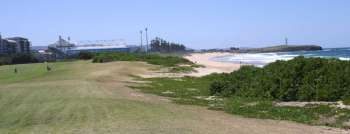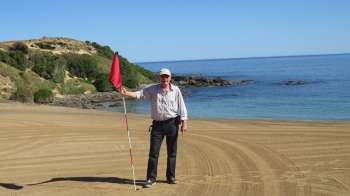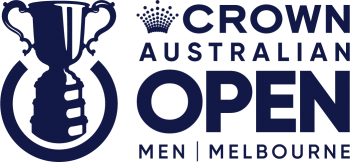Raising the Bar – a report card on select Australian golf clubs
Recently American golf architect Gil Hanse visited the Melbourne Sandbelt, chiefly to study our leading courses and find inspiration for his 2016 Olympic layout in Rio, Brazil. While in the city Hanse and his design partner Jim Wagner took in ten courses in total, and at the conclusion of their trip gave a frank assessment of where they felt each course stood. It led to further conversations about old golf courses in other parts of Australia, how far some had slipped in recent times and how difficult it would be to improve them.
(Note: look for an interview with Gil Hanse in next month’s Australian Golf Digest.)
On the back of these conversations Planet Golf decided to compile a report card on some of our under-performing golf clubs, focusing on those we believe are either most desperately in need of design assistance, or those that would benefit most from sensible change. (the comments below represent our views, and not those of Gil Hanse or other golf course architects)
Assuming that these clubs accept there are problems with their courses, the potential for significant improvement is considerable. While some clearly need to bite the bullet and undertake wholesale reform, other clubs are only a sensible tweak or two away from reaching their potential.
Given the high Australian dollar and the global downturn in golf development and construction, golf clubs here are now able to cherry pick the world’s best architectural talent. Finding the right person is crucial, and the only way to ensure a positive outcome is by appointing the architect most capable of producing outstanding results based on the budget, site and ambition of the club. If decision makers are unfamiliar with the redesign/restoration work of people like Hanse, Kyle Phillips, Tom Doak, Mike DeVries and others they are unlikely to fully understand the possibilities.
It’s important to keep in mind, that good redesign/redevelopment projects are not about improving on a ranking list or making things harder but rather about providing members with a more enjoyable golf experience. These are critical times for golf in this country, and we hope these critical comments are read in the constructive tone they were intended. Naturally we would be happy to talk to members or representatives at any clubs.
Yarra Yarra Golf Club
How good is it? 0 flags (40-60 in Australia)
How good can it be? 1 flag (10-20 in Australia)
Member Stress - High.
Comments – Of all the Sandbelt clubs, Yarra Yarra has fallen the furthest from its true potential. There are no longer any quick fixes here, and quantitative improvement is only possible with bold, sweeping change. On top of the very obvious tree and safety issues the club faces, there are serious problems with tees, bunkers, greens, green surrounds and the native ground vegetation. Design wise the course has become a dog’s breakfast.
Fortunately Yarra Yarra has retained its prestige and there is no doubt that it remains both an appealing club to join and also to work for. In our view, the best chance of Yarra returning to the upper echelons of Australian golf is for a fresh set of accomplished eyes to look at the course and determine what should be restored and what should be replaced.
How likely is appropriate action – Yarra Yarra used to be one of the premier courses on the Sandbelt, and golfers across the city would love to see it return to that level. The current state of the 2nd, 3rd, 5th, 6th, 7th, 8th, 10th, 12th, 14th and 17th holes should ensure that members keep the pressure on their board. We don’t see why each of these holes can’t be terrific. Ultimately, cost and member apathy are perhaps the greatest risks to improvement here.
Huntingdale Golf Club
How good is it? 0 flags (40-60 in Australia)
How good can it be? 1 flag (15-30 in Australia)
Member Stress - Medium.
Comments – In 1985 GOLF Magazine (USA) ranked Huntingdale 61st in the world, and 3rd in Australia behind only Royal Melbourne and Kingston Heath. In truth, the course was never really that good but it was certainly much better in the 1980s and early 90s than it is right now. Ranking lists are clearly not always an accurate guide, but the fact that both the Australian Golf Digest and Golf Australia panels have been quite savage on Huntingdale over the last decade is telling. Both magazines rank the course in the high 30s, and it’s pretty hard to argue with their assessment.
Despite its very apparent problems, this club has great potential and an ambitious and progressive board could do wonders here. Our hope is that the board isn’t looking to return Huntingdale to the glory days of the 1980s, but instead aiming to make their course even better than it was back then. Any one of five or six ‘quality endorsed designers’ has the ability to elevate Huntingdale back into Australia’s elite, but such a rise would only be possible with an ambitious design brief and an honest acknowledgement of the course’s current shortcomings.
How likely is appropriate action – Given what’s occurred here over the last 20 years, we aren’t overly confident that Huntingdale will get its ‘on course’ mojo back anytime soon. Though the club still technically exists within the Melbourne Sandbelt, it will remain on the outskirts until its character is repaired and the actual holes on the ground are enhanced.
Peninsula Country Golf Club – North Course
How good is it? 1 flag (15-30 in Australia)
How good can it be? 2 flags (7-12 in Australia, Top 100 in the World)
Member Stress - Low.
Comments – Peninsula has aims to be regarded among the Sandbelt elite, and recently hired one of this country’s premier turf professionals in its quest to elevate course conditioning. The North Course was redesigned ten years ago, and is the club’s shining jewel. It features a number of terrific holes draped naturally across some of the finest terrain in Melbourne.
There are some odd spots, however, and a number of holes feature redesigned fairways and tees but original, inappropriate green sites. Structural change to the 9th hole is needed at some point, while the 6th and 8th are a decent green complex away from being genuine Sandbelt superstars. A number of other very minor tweaks are required for this course to fulfill its potential, which would be alongside the likes of Victoria and Royal Melbourne East as the next best in Melbourne after the West Course and Kingston Heath.
How likely is appropriate action – Given the relative ease and low cost of improvements on the North Course, Peninsula is expected to undertake work on some of these underperforming holes in the not too distant future. Like many clubs, the only real stumbling block here may be that members don’t realise just how good their ‘little’ course can be, or how close the club is to reaching its potential.
Southern Golf Club
How good is it? 0 flags (60-100 in Australia)
How good can it be? 1 flag (20-40 in Australia)
Member Stress – Low/High.
Comments – Somehow Southern fell off the Australian Golf Digest Top 100 ranking list in 2012, which surprised those who have enjoyed this course and its typically well kept fairways and greens over the years. Clearly good turf is no longer enough, and Southern would probably admit that they haven’t handled course works well over the past decade or more.
A large part of the problem lies with the esteem in which life member, and course designer, Bob Shearer is held here. Shearer has been a great servant of the club, and is rightly revered by his fellow members. They probably shouldn’t have let him near the design, however, not because he doesn’t have the ability to produce good work but because they don’t seem to have the capacity to be as demanding as a golf club client needs to be. It can be comfortable working with friends or long-time associates, but when work deviates from an agreed set of plans or isn’t to the standard required then the club needs to be able to express its displeasure and to demand remedial action.
With respect to the previous masterplan, we believe that a new one is needed and a fresh set of eyes cast over what remains a pretty solid golf course. Again the routing here is fairly good and it’s really only the design of greens and bunkers together with the mounding, trees and ground vegetation that need addressing.
Like many second tier clubs on the Sandbelt, Southern just needs to get a little more ambitious. It’s never going to be the best course in Melbourne but it can be significantly better than it is now, and a sensible redevelopment wouldn’t cost anywhere near what other clubs have spent on course works.
How likely is appropriate action – We don’t believe that Southern has the resources needed to properly upgrade their golf course quickly, but they should be able to recognise the value of a quality masterplan and a carefully considered step-by-step implementation program. The ‘high stress’ aspect of any change at Southern Golf Club for the members is telling one of their own that they need to use somebody else.
Royal Fremantle Golf Club
How good is it? 0 flags (80-120 in Australia)
How good can it be? 1 flag (15-30 in Australia)
Member Stress - High.
Comments – Perth should be one of the great golf cities, with its perfect climate, sandy soils, undulation and ideal daily wind shifts. Many of the leading private clubs around the city are quite tight, but Royal Fremantle has room and it also has great topography and scale. There are certainly too many trees here, and the routing is full of holes but the potential is enormous and with a bold and sensible redevelopment this course could easily become the best in the West. For that to occur Royal Fremantle would need to overcome this peculiar reluctance WA clubs have of hiring architects from outside the state.
How likely is appropriate action – Without knowing Royal Fremantle’s financial situation, it seems unlikely that the club would embark on an overly ambitious redevelopment program without significant cash reserves. If that’s the case, perhaps the best we can hope for is an appropriate masterplan that they slowly work through over a number of years. Like other clubs mentioned here, this one probably needs to be convinced of the potential of its property in order to get the most out of it.
St. Michael’s Golf Club
How good is it? 0 flags (60-100 in Australia)
How good can it be? 1 flag (20-40 in Australia)
Member Stress - High.
Comments – I’m sure many would argue that tact is not one of my strong suits anyway, but when it comes to St. Michael’s the time for niceties and for tiptoeing around their problems has long passed. This club is heading down a desperately dangerous path with their golf course, and its bottom line is being affected. The tranquility of their ocean setting is no longer enough, and the club is finding that members and prospective members are favouring Bonnie Doon. That trend will likely persist as the Doon’s redevelopment continues.
The first myth to bust here is that St. Michael’s can’t afford to develop a proper masterplan nor undertake reparations with a quality golf course architect. The truth is they can’t afford not to. While they won’t be able to proceed as quickly as Bonnie Doon, a plan for the future is crucial and in the long term would almost certainly save the club money. Much of the work done in recent times is going to need to be repaired anyway, and at some expense.
The more this club continues with ad hoc design changes the harder it becomes to rescue the situation and pull everything together in a unified and consistent manner. That’s all fans of St Mick’s want, for the place to look and feel like a proper seaside course and for the holes to work together and make strategic sense. They don’t need to change all 18 holes at once, but if they want to get the most out of their property and own one of Sydney’s premier golf courses then all 18 will need some work. That’s obviously a major program, but one that could be done over a period of several years. First they need a plan, and they need to very carefully consider the most appropriate architect to put that plan together.
How likely is appropriate action – While at this point it seems unlikely, passionate golf people always have hope.
Wollongong Golf Club
How good is it? 0 flags (100-200 in Australia)
How good can it be? 1 flag (30-50 in Australia)
Member Stress - Medium.
Comments – Despite being home to a number of golf courses, the Illawarra is a fairly underwhelming golfing region. The Wollongong Golf Club should be an exception, but unfortunately despite some astonishing natural advantages it fails to really appeal. This is a course that sits right in the heart of the city, and on softly tumbling dune land adjacent to the Pacific Ocean. The views are tremendous and the terrain in places is perfect for bumpy, linksy golf. Makes you wonder then why it is filled with small ponds, safety nets and some of the most dangerous holes in Australia.
The water problem here is a very real one, because council has made the club’s life difficult with regards the distribution and storage of storm water. We aren’t sure how much of the water can be shifted from the course, but we do know that the coastal strip close to WIN Stadium can be incorporated into the layout and that the far holes can be made a lot safer and more interesting.
There is no reason why this club can’t become Sydney’s Barwon Heads, although to achieve it they would need to fix the internal safety issues, reroute a section of the course and just build better holes. Great golf architects the world over get excited by sand, sea and undulation – Wollongong would appeal to many.
How likely is appropriate action – The club has poker machines and a successful accommodation business, but aren’t necessarily flush with cash to spend on major design changes. They first need to be convinced their site has real quality, and that with a sensible (and inexpensive) redesign it could become a genuine little gem.
Kooyonga Golf Club
How good is it? 0 flags (25-50 in Australia)
How good can it be? 1 flag (10-20 in Australia)
Member Stress - Medium.
Comments – If Kooyonga wasn’t so well maintained it’s possible that more members would be upset by the recent changes made to their course. From the outside it’s difficult to gauge the appetite for radical directional change here, but we aren’t the only impartial and dispassionate observers shocked at what’s taken place in recent years. It’s not just the new par four 5th hole, it’s the mounding, the bunkering, some of the green contouring and the vegetation and tree management. Virtually everything done over the past few years has been designed to make holes more difficult, with little consideration given to what would make holes better or more interesting. Our fear is that this mentality will continue, as suggestions have been made to move the par three 3rd hole in order to enable both the 4th and 9th to be stretched further.
Dr MacKenzie spoke in ‘The Spirit of St Andrews’ of the importance of finality in design. Kooyonga is one of those clubs that need to look into the mirror and determine what the end goal is and how their course should ultimately be arranged. The next step is to determine the architect best able to guide them through to completion, and in our view the short-list here is very short. This club is too important and the course has too many quality areas for the next appointment to be made in haste or on reputation alone.
How likely is appropriate action – This is a great club with a great golf culture, and for decades they managed to strike a better balance between providing a tournament test and an enjoyable challenge for their members. We are confident that eventually they will repair damaged parts of the course and reestablish themselves as Adelaide’s clear number 2.
Brisbane Golf Club
How good is it? 0 flags (80-120 in Australia)
How good can it be? 1 flag (15-30 in Australia)
Member Stress - Low.
Comments – The Brisbane Golf Club was badly affected by the terrible Queensland floods of 2011, but the course seems to have bounced back remarkably well. It’s very well maintained and the holes occupy nice ground and have enough space to enable more width, and therefore more strategy, to be injected into the design.
We doubt that major structural change is something members or powerbrokers are likely to be considering right now, but this club does have great potential and should rival RQ as the best course in the city. The routing here is fine, and this is the sort of property where a slow, sensible hole-by-hole improvement program could make a huge difference.
How likely is appropriate action – The prospect of Brisbane GC sitting comfortably among Australia’s best 30 courses might seem a pipedream, but the opportunity certainly exists if the members are motivated enough.
Feedback – If we missed the mark here, or left any obvious candidates for redesign/restoration out let us know at darius@planetgolf.com.au. In the near future we will be looking at some of Australia’s success stories, and steps taken by clubs to arrest deterioration and improve the golf available for members.
Back to NewsMore News
Who Really Designed Cape Wickham Links?
AGD ranks Cape Wickham #1 in Australia & interviews Duncan Andrews to get full story on course design
2026 Crown Australian Open Dates Confirmed
Golf Australia confirms that next years Open will be held from December 3 to 6 at Kingston Heath
Golf Australia unveils new pathway for social golfers as participation surges
Participation surpasses 4 million in 2024/25, with social memberships growing faster than club memberships
Spain's David Puig wins BMW Australian PGA Championship
It was billed as a Sunday shootout, but LIV star's bogey free weekend delivers a commanding PGA triumph





